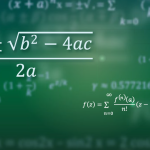An illustration of Babai's algorithm for the Closest Vector Problem (CVP): Find the closest lattice point for a given lattice and a target vector. Source: http://tex.stackexchange.com/q/42564/

Edit and compile if you like:
% Drawing lattice points and vectors
% Author: Bill Tourloupis
\documentclass{article}
\usepackage[active,tightpage,floats]{preview}
\setlength\PreviewBorder{30pt}%
\usepackage{tikz}
\usetikzlibrary{calc}
\begin{document}
\begin{figure}[ht]
\centering
\begin{tikzpicture}
\coordinate (Origin) at (0,0);
\coordinate (XAxisMin) at (-3,0);
\coordinate (XAxisMax) at (5,0);
\coordinate (YAxisMin) at (0,-2);
\coordinate (YAxisMax) at (0,5);
\draw [thin, gray,-latex] (XAxisMin) -- (XAxisMax);% Draw x axis
\draw [thin, gray,-latex] (YAxisMin) -- (YAxisMax);% Draw y axis
\clip (-3,-2) rectangle (10cm,10cm); % Clips the picture...
\pgftransformcm{1}{0.6}{0.7}{1}{\pgfpoint{0cm}{0cm}}
% This is actually the transformation matrix entries that
% gives the slanted unit vectors. You might check it on
% MATLAB etc. . I got it by guessing.
\coordinate (Bone) at (0,2);
\coordinate (Btwo) at (2,-2);
\draw[style=help lines,dashed] (-14,-14) grid[step=2cm] (14,14);
% Draws a grid in the new coordinates.
%\filldraw[fill=gray, fill opacity=0.3, draw=black] (0,0) rectangle (2,2);
% Puts the shaded rectangle
\foreach \x in {-7,-6,...,7}{% Two indices running over each
\foreach \y in {-7,-6,...,7}{% node on the grid we have drawn
\node[draw,circle,inner sep=2pt,fill] at (2*\x,2*\y) {};
% Places a dot at those points
}
}
\draw [ultra thick,-latex,red] (Origin)
-- (Bone) node [above left] {$b_1$};
\draw [ultra thick,-latex,red] (Origin)
-- (Btwo) node [below right] {$b_2$};
\draw [ultra thick,-latex,red] (Origin)
-- ($(Bone)+(Btwo)$) node [below right] {$b_1+b_2$};
\draw [ultra thick,-latex,red] (Origin)
-- ($2*(Bone)+(Btwo)$) node [above left] {2$b_1+b_2$};
\filldraw[fill=gray, fill opacity=0.3, draw=black] (Origin)
rectangle ($2*(Bone)+(Btwo)$);
%\draw [thin,-latex,red, fill=gray, fill opacity=0.3] (0,0)
% -- ($2*(0,2)+(2,-2)$)
% -- ($3*(0,2)+2*(2,-2)$) -- ($(0,2)+(2,-2)$) -- cycle;
\end{tikzpicture}
\caption{Babai's algorithm works poorly if the basis is ``bad''.}
\label{figure:solving-CVP-bad-basis}
\end{figure}
\end{document}
Click to download: lattice-points.tex • lattice-points.pdf
Open in Overleaf: lattice-points.tex

